|
“Everybody already knows what we do.”
Unless you are Roto-Rooter, Chevrolet or Hostess, that statement is a bald-faced lie. Please, do not make this mistake born of hubris—a fitting word, as it has its roots in Greek tragedy. In fact, I went to The Source Of All Knowledge, Wikipedia, for a quick lesson in Hubris. Seems it describes the following: …a personality quality of extreme or foolish pride or dangerous overconfidence, often in combination with (or synonymous with) arrogance. The term "arrogance" comes from the Latin adrogare, meaning to feel that one has a right to demand certain attitudes and behaviors from other people. Hmm. I’ve seen that before. That actually describes a whole lot of what has been happening in American politics over the last few years. But for the moment, let’s stick with marketing. The hubris of which we’re speaking regards a kind of attitude that one is immune from doing smart things. For more than a decade, I made my living writing radio advertising for businesses of all sizes, from local garage-door companies to GEICO. Frequently, when an advertiser was struggling, it was largely because they were unbranded. They would invariably be offering a “me-too” parity product or service. There would be no clear brand and no clear way that the prospect was supposed to feel about the business. The solution would be simple enough. I would suggest solidifying the brand position and running a branding campaign that gives the advertiser a higher profile and a clear position. The response was often, “That’s not necessary. Everybody already knows who we are.” That might be one of the most self-aggrandizing attitudes imaginable when you’re the same person who’s saying, “The advertising isn’t working.” In the course of a busy day in a busy life, who can possibly make room for every advertising message from every advertiser who wants the prospect to care as much as they do about what they sell? But, you know what most people can make room for? An advertiser who’s surprising, who commands attention, and who wants us to know what they stand for. If I’m not in the market for a car, your car dealership’s great prices this week only are irrelevant to me. But if you make me believe that your car dealership is like a club for your customers who drop in just to say hi, and you have legions of ecstatic fans up and down the state, I might think, “Wow. I need to go there when I’m ready for another car.” One reason I’m addressing this problem right now is that it’s epidemic across this nation. Having driven several thousand miles in the last three weeks, I can’t tell you how many times I’ve seen this: A big billboard. A silly headline. A visual joke. A non-descript business name. And zero idea of what the advertiser sells, how I’m supposed to feel about them, and what they think they’re accomplishing with that billboard. Saw one today. A silly word. A goofy guy in a superhero outfit. A smiling woman. And no other information. Hunh? There’s a guy in my home state who has billboards with his name and the tagline, “One call, that’s all.” It took me years to figure out the guy was a personal-injury attorney. That’s because I finally saw one of his TV commercials. “But everyone knows what I do. The billboards are just supporting the TV that everyone knows.” Dude, not everyone knows. The irony here is that I’ve often compared an advertisement to an argument in a court of law. Present a case that makes the prospect feel the right way, and they’ll decide in your favor. If your advertising is struggling, or if your client’s advertising is not working, back away from the hubris. Do not end up in a Greek tragedy that ends with a plummet from grace because someone believes they’re above good strategy. Traditional media are struggling. Advertising is a struggle. The world is more competitive than ever. And there is no competitive edge in hubris. Not everyone knows wo you are. But everyone is desperate for something to believe in. Cheers, Blaine Parker Your Lean, Mean Creative Director in Park City LIGHTNING BRANDING ON AMAZON The Kindle edition of our new book is now available at Amazon for the bargain price of $19.95. For details about our new Lightning Branding courses, both do-it-yourself and we-do-it-with-you editions, click here. (There's even a video of us!)
0 Comments
“What?! Of course not! You’re out of your brand-loving mind! Go back to beneath whatever godforsaken marketing rock you crawled out from under!” OK. I’m out of my mind. In some minds, “subversive” might conjure an image of a Molotov-cocktail throwing revolutionary who meets his swarthy, mustachioed cohorts in dark basement cafés to plot revolution against the ruling party while smoking a thick, harsh, unfiltered cigarette with a hard-to-pronounce name like “Gauloises.” And yes, that is a kind of subversive. But let’s look at the core definition of the word. “Subversion” is about taking power from an established authority or institution. That definition does not hinge on being able to meet in a smoky, dark basement or heaving a bottle of petrol stuffed with a flaming rag. The important component is taking power. And not necessarily absolute power. Some power is sufficient. And it’s arguable that branding is a form of subversion when the goal is to win customers from the competition. Taking away customers is a form of winning power. One of our first clients was a general dentist who said, “We want to run some ads for implants!” We said, “You could do that. But you’re competing against a branded national giant called Clear Choice. How about developing a brand that’s in direct competition?” The resulting brand gave the dentist a clear and evocative profile as an implant specialist. In the first year, that brand took in close to a million bucks. Could that near-million bucks have gone to Clear Choice? Of course. But our client took that chunk of power. Subversive dentistry, at your service! What about the sound of power down the drain? Back in my radio days, we helped a plumber do some backward branding. The account rep and I reverse engineered branded advertising for the plumber. It took that local plumber to #2 in the market for top-of-mind awareness. You can argue that this small-business brand was taking power from #1 plumber, an outfit called Roto-Rooter. Subversive branding is helpful for small-business survival. The small-business brand need take only a tiny fraction of the customer power that would go to the 600-pound gorilla. How many stories have you heard about communities rallying against a proposed big-box chain store? The big national brand wants to come to town and subvert power from established local business. More than one Walmart has drained the power and authority from a nearby main-street commercial district. The Home Depot brand has put more than one local hardware store out of business. “You can do it, we can help!” That’s a (now defunct) Home Depot tagline. It also has some grim meaning when couched against the act of ruining local businesses. Local bookstores were crushed by subversives called Waldenbooks, Barnes & Noble and Borders. Later on, those three subversive giants were a subversive outfit called Amazon. A big national brand can subvert an authoritative local business. Then, fans of local businesses cry, “That’s not fair!” But on a clinical level, commerce is not about fairness. It’s about exchanging goods and services. If a small business wants to exchange goods and services against a giant competitor, isn’t it necessary to take away even a modicum of power? Small businesses need and deserve brand. Be David. Take the power from Goliath and thrive. Cheers, Blaine Parker Your Lean, Mean Creative Director in Park City  ...or hear it in the author's own voice. ...or hear it in the author's own voice. If you've been hanging around here for any length of time, you're sick of hearing us say it. Your brand is the one way your Core Customer should feel about your business. One way, because focus is essential. Feel, because all decisions--including buying decisions--are made emotionally and justified later. Core Customer because, when you understand the one person to whom you're speaking, you understand how to be resonant and relevant. With that in mind, allow us to look at that simple, ground-corn product, the humble tortilla chip. Specifically, let's look at a small, regional brand here in the west that goes by the name, Juanita's. JUANITA'S IS A TORTILLA CHIP OF DISTINCTION This is a chip that one might refer to as "restaurant-style." It's a rustic product made of stone-ground yellow corn, a trace of lime, vegetable oil, salt and water. Juanita's is a classic American success story. An immigrant Mexican family moves to Hood River, Oregon. In the 1970s, they rent a room and start making mom's authentic, Mexican-style corn tortillas to sell in local markets. One by one, the family members leave their other jobs and work in the tortilla factory. Today, they're huge in a regional kind of way. If you want to read the story, it's on their website. On the bag, there is a topline version of the story: "To make a great tasting tortilla chip, you first need to know how to make a great tortilla. For over 50 years our mother has prepared fine, authentic Mexican meals insisting on only the finest ingredients. And for over 26 years our family has brought to the public the same dedication to quality with the brand named after her .... Juanita's." WHEN THE FABULOUS HONEY PARKER AND I THROW A PARTY, THIS IS OUR GO-TO CHIP We serve it with a homemade salsa cruda, which is basically a mix of chopped tomatoes, onions, peppers, cilantro, salt and lime juice all stirred up in a bowl. Our guests scarf it down. And someone always asks, "What kind of chips are these? They're great." We show them the simple bag with its red and green logo that looks like the signage off an old Los Angeles taco joint. They nod and crunch. Last week, when I went to buy Juanita's for our traditional July 4th barbecue at the Mountaintop Marketing Fortress... The supermarket was out. On the shelf, there was an enormous void where our beloved Juanita's usually live. Holiday locusts had descended ahead of me. I began perusing the alternatives. There were a couple of brands that seemed equally rustic and unsophisticated in their branding. But I looked at one that seemed especially relevant. LA COCINA DE JOSEFINA I already knew the story of Juanita's Horatio Algero roots. I looked at the bag of chips from La Cocina De Josefina, and it seemed equally unsophisticated. A simple drawing of a Mexican woman rolling out a tortilla by hand. Turning the bag over, it was not dissimilar to Juanita's: These tortilla chips are made with the simple ingredients of corn, oil, salt... and love, --- because we believe that every bag of La Cocina de Josefina chips is an invitation. To share. To connect. To come together with people who are important to you. Made right here in the Pacific Northwest, we care greatly about the product we create for you, and make sure to only use quality ingredients. The result is a flavorful tortilla chip that we think you'll find simply delicious. So grab some friends, open a bag and enjoy! SOLD AMERICAN! With the dearth of Juanita's, two bags of Josefina's went into the cart. The salsa was a hit. People scarfed down 97% of it using a bag and a half of chips. The next evening, I was sitting with the leftover chips, considering how much they tasted like a Fritos corn chip. Could Josefina have displaced Juanita in my chip repertoire? Looking at the bag, it seemed odd that there was no website listed in the labeling. Wondering about Josefina's heritage, I googled her chips. Dear God, what have I done! This rustic tortilla chip, made with the simple ingredients of corn, oil, salt, and love... Is a poseur! Or, as they would say in Spanish, "Presumido!" The chips from La Cocina De Josefina are made not with love at all, but with filthy corporate lucre! JOSEFINA'S CHIPS AND HER SIMPLE DRAWING OF HER ROLLING OUT A TORTILLA... ...are a product of Frito-Lay, Inc.! Be still my heart! Nowhere on the packaging is there any indication of this relationship. The closest they come to any admission is in the address: Made in Vancouver, Washington for La Cocina de Josefina by Cocina Autentica, Inc. 4808 NW Fruit Valley Rd. Vancouver, WA 98660 Google that address, and you get a map of Frito Lay's Vancouver production plant. But why? Why this lie by omission? FOR EXACTLY THE REASON INDICATED AT THE BEGINNING OF THIS SCREED The Frito-Lay marketing department knows that a brand is the one way the Core Customer should feel about the business. One way, because focus is essential. They have focused on creating what seems to be a family-owned brand of chips. Feel, because all decisions--including buying decisions--are made emotionally and justified later. And any simple chip "made with love" is a viable substitute for the absent Juanita. And Core Customer because they want to have a voice that is resonant and relevant. They understand they are speaking to someone who appreciates the rustic family nature of Juanita's brand. Understanding how this person feels about Juanita's helps them matter in this person's quest for chips over, say, Tostitos. But why have they done this? Why has this big dog perpetrated this big lie by omission? THIS IS A CORPORATE STRATEGY Publicly, they say that they don't mention Frito-Lay because it is a regional product only. Frito-Lay is a national brand. But dig a little deeper, and you find that Frito-Lay has a new strategy of going after strong regional brands. And wisely, they look at someone like me, who's a fan of my regional brand. They know that in no way would I, in looking for a substitute for my Juanita's, buy a product from a subsidiary of a $75 billion company. But the small-brand BS stamped on the back of their bag, along with the homespun look of the package, is exactly what they know I will respond to. I have been played! And this proves exactly why Slow Burn Marketing insists that as a small business in the 21st century, being competitive in one's marketplace requires understanding what it means to have an evocative brand. THIS BIG DOG HAS DONE NOTHING ILLEGAL But they have concocted an implicit lie of a brand in an effort to squeeze out a little guy. Is it fair? Absolutely. Do I have anything against Frito-Lay? Absolutely not. Am I glad to have been duped like this? You betcha. Because not only does it make me a smarter consumer. IT ALSO GIVES ME GRIST FOR THE SCREED MILL Like so much yellow corn being stoneground for tortilla chip slurry, we have a salty object lesson for the small-business marketer. If you brand well, and you build your business, you can become a threat to the big dogs. If you were around a few weeks ago when we talked about Dollar Shave Club and their acquisition by Unilever last year for a billion dollars cash, that's another example of threat management. Wisdom on the street is that Unilever paid far more than the brand was worth just to prevent someone else from buying it. Most of us will never be big enough to inspire fear and big-money attacks or acquisitions. Some will. There are a few followers of the screed who will make it happen. But by understanding why branding works and knowing how to throw an emotional dart at the heart of your customer, no matter how small you are, you can win big in your marketplace. Mere component parts like corn, oil and salt are beaten into the ground by the idea of love. Even if it's all a lie. As always, Blaine Parker Your Lean, Mean Creative Director in Park City  ...or just listen. ...or just listen. When we were doing a lot of live presentations, this is a refrain that the Fabulous Honey Parker and I would repeat from the stage. The reason that we would say it is because, for the small-business owner, it was true. We also used examples of people who had changed their businesses by rebranding, and had changed their lives. We even had videos of them, saying things like the new branding "taught us how to be out in the world." That might seem like a strange thing for a grown adult to be saying--until you realize that the person who said it is also a professional actor. And who knows better the need for cues about "How to be out in the world" than someone whose performance upon a stage requires an objective third party providing direction? AND OF COURSE, "ALL WORLD'S A STAGE... "And all the men and women merely players..." We'll not be going far enough into that old chestnut to get to the less popular line about "mewling and puking." Instead, we'll just point out that the Bard of Stratford Upon Avon himself gave us the metaphor about the world being a stage. And an actor on a stage benefits from direction by a third party. And last week we, as de facto directors of brand, had an in interesting experience out in the world. We did something unusual. We visited a client business, and personally presented the new brand to 45 employees. Understand, we have no problem visiting a client's business and making such a presentation. It's just that, for many small-business owners, the branding budget is micro-sized. GETTING ON A PLANE FOR SUCH A VISIT IS A LUXURY Especially if a client is in hard-to-reach rural New Hampshire or tropical-paradisiacal Cebu. But when a client is as big as this one, and the plane flight is only 90 minutes, why the heck not? Besides, this was a big deal. After 38 years in business, this family retail superstore was changing its brand name. The original name, if uninventive and unsurprising, was clear. Which is fine. Building an empire over 38 years is one heck of an achievement. If you can do that by giving yourself a clear and obvious name, have at it. BUT THIS IS THE 21ST CENTURY It was deemed time for this business to evolve its brand to meet the 21st century. They need to compete in a way that brings retail customers in out of the internet and into a brick & mortar store--especially to a store that's family-owned and flies in the face of the institutionalized and mediocre experience at its big-box competitors. This brick & mortar store is superb. Theirs is a retail experience unlike any other in the category. It's the kind of place that makes you glad family-owned retail stores still exist. Populated by good people and excellent products, they make you feel welcome, they make you feel at home, and they make feel like you're doing something really good for yourself. Those kinds of things are really important to this brand. And they weren't being reflected in the branding. SLOW BURN'S JOB WAS TO DO SOMETHING ABOUT THAT Over the last few months, we'd been interviewing the management team, key staff members and select customers. We'd been putting the information gathered through the Slow-Burn branding processor. And the results that came out the other end? They have made the management team giddy. It was now time to unveil the brand to the people who make the business happen every day. So we stood there, in the store, in front of about 45 people. This included the founder, the owners, management, sales staff, office staff, warehouse staff and truck drivers. Everyone who impacts this brand, and is impacted by it, was sitting there, eating bagels and drinking coffee and waiting patiently. And honestly? I HAD A LITTLE TREPIDATION Not about speaking to a crowd. After all, Honey and I have stood on stages as far flung as Los Angeles and Kuala Lumpur, speaking to audiences of thousands of small-business owners, explaining brand and how it can make their businesses stronger. But this was the first time that we had ever stood in front of four dozen people whose lives were about to be impacted by a new mission statement, a new goal, their first-ever core customer definition, and a designation for the one way that core customer should feel about their business. How were they going to take it? Would they be glad to have new, de facto rules? Or would they resist? Would they say, "Who are these carpetbaggers and why should I heed their directives?" WHAT WOULD HAPPEN? Cue the PowerPoint! It took about 20 minutes. Technically speaking, our performance went well. But watching the audience--watching everyone from the founder to the truck drivers--it was clear that something was happening. It was clear that a new brand name, new signage, new truck graphics, even new business cards--along with a new tagline--had flipped a switch. You could see sales people nodding their heads. You could see warehouse workers and truck drivers lighting up. You could see the founder getting choked up. As the manager said to me afterwards, "I really like the buzz in here this morning." YES, THEY ALL APPLAUDED WITH ENTHUSIASM But something more important happened in those moments. Everyone on the staff became galvanized. They were suddenly able to rally around a new name and a new brand and a new way of being in the world. And they also had new business cards. That might sound insignificant. But this business card is sexy. It looks--and feels amazing. Grown men have been seen fondling it beyond what is considered a decent interval. And when you drive a truck for a retail store, and you've never had a business card? THIS IS A GAME CHANGER Afterwards, one of the truck drivers came to the founder. He said, "So, if I go on a delivery, and I give that woman my business card, and she feels happy enough that she gives it to someone who comes into the store to buy something, what do I get?" All of a sudden, the truck driver was ready to up his game. His participation in the circle of retail life had more impact. He was ready to drive more than just a white box truck. He was ready to drive business. He was ready to make that customer feel one way about the store he works for. It was gratifying that salespeople came up individually and thanked us for the work. IT WAS UNEXPECTED THAT TRUCK DRIVERS WOULD EMBRACE IT EQUALLY For years, we've had clients tell us how new branding galvanizes their teams. One even spoke about how it was like flipping a switch. When she presented the new brand and its new language to her staff, they immediately rose to it. It changed the performance in her office that very day. But this was the first time we had the privilege of watching the result with four dozen people in attendance. And it changed everyone's demeanor that very day. Management is now deciding how they're going to incentivize and reward truck drivers (and anyone else not in sales) for driving business to the store. And the owners are feeling something they haven't felt in a while. THEY FEEL THE STRUGGLE MELTING AWAY An outdated name. An outdated and incongruous look. To hear them describe it, it was almost as if there were a millstone around their necks. Rebranding is an act of courage, especially after 38 years. And now, they have a brand new suit of clothes. They have a new way of knowing how to be out in the world. We feel a little like Stacy & Clinton from What Not To Wear. Do not underestimate the value of what your brand does for your psyche. The right focus on how to be out in the world is a powerful thing. And it can make everyone in your business raise the bar and do better for themselves--and for you. Change your business. Change your life. Change your brand. As always, Blaine Parker Your Lean, Mean Creative Director in Park City  Listen to the Podcast Listen to the Podcast WANT OVERNIGHT FAME AND FORTUNE BY BUILDING AN INTERNATIONALLY-KNOWN, SMALL-BUSINESS CULT BRAND? Then get busy. The brand we're going to use as a model for your overnight success is very sexy. Your brand will also be years in the making. That's the reality of most overnight successes. Cruising easy-breezy into the international spotlight is simple: do a lot of planning, a lot of leg work, get repeatedly hot and grubby, and be intensely focused. Simply put: be prepared to just work your ass off. Our model brand here is built by a smart, good-looking couple working in a stunning environment. Azure blue waters. White sand beaches. Muscular, suntanned yachties as customers. This couple is a living, breathing, made-for-photos-and-TV example of small-business brand focus. And if you're equal parts courageous and crazy, you can do what they do.  THEY ARE EXACTLY WHAT YOU'D EXPECT FROM A PIZZA BUSINESS Yes, pizza. Really. On TripAdvisor, their brand has become the #1 restaurant in St. Thomas, USVI--which is saying something for an island destination whose lifeblood is tourism. That #1 rating is out of 204 restaurants rated by TripAdvisor users. Here's the catch: to get their pizza, you need a boat. The pizza is being served to boaters in St. Thomas from a sailboat anchored in beautiful Christmas Cove at Great St. James Island. The business has garnered international attention in the press, and became an overnight sensation. It has been covered by the press internationally, and has become a bustling operation that serves about 70 pizzas a day. (That might not seem like a lot relative to, say, any other pizzeria anywhere. But how many of those pizzerias are on a boat in a remote location?) And who is this happy couple and what is their bustling little business bobbing away at anchor in paradise? MEET CHEF TARA AND CAPTAIN SASHA OF PIZZA PI These two are certified Smart People. Capt. Sasha graduated from MIT before going to Wall Street and working for Standard & Poors. That lasted about six years, until he "chucked it all" to become an instructor at the New York Sailing School. Of course, as great as sailing in New York Harbor is, it has little on sailing in the limpid, cerulean waters of the Caribbean. So Capt. Sasha lit out to the Caribbean, where he began captaining boats. That's where he met Chef Tara. A special education teacher from Indiana, Tara was spending her summers in the British Virgin Islands as a scuba instructor. Meeting Capt. Sasha put a voluntary end to the teaching career, as Tara decided to "Chuck it all to follow [her] heart & boyfriend into a life of sun and sailing." Which led to a new career as an award-winning chef aboard charter yachts. BUT SMART PEOPLE OFTEN NEED TO DO CRAZY THINGS That's my analysis, not theirs. But let's face it: what they did seems just a little crazy. They decided they needed to open a food truck. Except they're in the islands. So naturally, the food truck had to become a food boat. And that food boat would fill a void so glaring, it seems almost painfully obvious that someone should have filled it--except that most sensible folks would say, "Nah, that's crazy!" Understand, I say this not just as some branding geek sitting high atop a mountain outside beautiful Park City, Utah. I say this is a guy who used to work on sailboats in the Caribbean, who loves pizza, and was one of many people in the same job who would sit around a boat at night, drinking a few beers or some excellent cheap rum, saying, "Damn, if only we could get a pizza delivered." None of us did anything about it, of course. IT TOOK TWO SMART, POSSIBLY RECKLESS, STARRY-EYED DREAMERS Again, my analysis, not theirs. They don't actually look starry-eyed or reckless. They might be dreamers. How else do you explain finding an old hulk of an abandoned 37-foot aluminum sailboat, refitting it as a pizza kitchen, and opening up shop in a tropical island anchorage where the only guaranteed traffic is from people with boats? And if the dream seems reckless, it helps to back it up with some good old-fashioned smarts and responsibility. I asked Chef Tara what kind of pizza they serve. She says, "Sasha is from NYC. I had no choice in the type of pizza we would be serving." OK, sell what you know. And as a Yankee who has eaten a lot of NYC pizza, I cannot begrudge the good captain his preferred pie. Tara continues, "We went to the Pizza School of New York to learn the art of NY style pizza and sauces. As a bonus we were also given a crash course in restaurant management and accounting." OK, EXPERT TRAINING IN ALL ASPECTS OF RUNNING THE BUSINESS HELPS It makes things seem a little less reckless. And if the results are any indication, their dream has been enormously realized. From Day Zero three and a half years ago, they've ramped up their business to the current slinging of 70 pies daily. They've also ended up as media darlings. There are dozens of news stories and videos about PiZZA Pi. They've even been covered by business-news giant Bloomberg. And, of course, their business is booming. I didn't pry into the financials of PiZZA Pi, but just doing some quick math, let's assume that nobody orders just a pizza. (They also serve soft drinks, alcohol, ice cream and nitro cold-brew coffee.) Let's just assume 70 tickets at an average of 30 bucks. THIS COULD EASILY BE A MILLION-DOLLAR-A-YEAR OPERATION But again, I'm just making a wild guess. Let's say it's half that. How many new businesses wish they could pull off even that? A wildly popular local brand, ranked #1 in their category by the fans, making a better-than-living-wage in paradise, winning friends and influencing people from around the world by serving pizza. This is such a tremendous small-business story for so many reasons. Wanting to know more so this small-business freight train of a brand could be shared with the Hot Shots faithful, I reached out to PiZZA Pi with questions. Chef Tara was good enough to reply. I asked her what she believes is the secret to their success. Chef Tara says, "The more I think about it, the more complicated this question becomes. PiZZA Pi has experienced success on many levels for a variety of reasons and together they equal success for the entire business & brand." "HERE ARE SOME OF THE MAIN POINTS THAT I FEEL HAVE REALLY HELPED US." "In national media, the notion of quitting your day job to pursue life in paradise has been trending in the past couple years. "When production companies hear about us they go nuts because we fit within their story line (left Wall Street to open a pizza boat), as a couple we don't look terrible on camera, and our business setting is visually stimulating enough to attract attention. "Being featured on national television, big-name print, and online publications has elevated our brand across the board and spread awareness and excitement to tourists traveling to our area." AND GUESS WHAT ELSE: THEY HAVE A MISSION STATEMENT! Believe it or not. As the faithful fan of the weekly screed knows, that's exactly the kind of thing that we here at the Mountaintop Marketing Fortress love to harp upon: have a clear and defined mission. And you want a good example of why that mission matters and how it informs the success of your brand? Chef Tara continues: "Our mission statement has been our guide as the company grows. It keeps us true to the initial reason for our existence." Oh, look. A guide. As the Fabulous Honey Parker would say, it keeps them good, right and true. Chef Tara says, "Consistency is key to surviving in a small-town atmosphere where your reputation is discussed everywhere from the bars to government offices." Oh. My. God. Consistency! If we do nothing else consistently here, we bang the drum for consistency. And never discount the significance of your reputation on the coconut telegraph. In a place as small as St. Thomas, a reputation is easy to acquire--and you better hope people like you. Bars to government offices, indeed. BUT WHAT'S THE MISSION? "Our mission statement is as follows: 'PiZZA Pi is a hip and wholesome "food truck on the water" that is out to have fun while serving up the best pizza in the Caribbean. We cater to day-trip, term-charter, and local boaters and are dedicated to surpassing expectations by serving small-batch, high-quality foods sold at a reasonable price by friendly, knowledgeable staff.' "Though our story is portrayed as having moved straight from NYC to owning a pizza boat, in reality it has been a ten-year adventure. Sasha and I left mainstream and worked as professional yacht crew in the Virgin Islands for a number of years and became intimately familiar with the marine industry and the surrounding communities. "It was with this base knowledge that we developed our business plan, chose a location, spec'ed out requirements for our boat, and assembled a team to help secure appropriate licensing. "We did open PiZZA Pi on a wing and a prayer, but we also (sort of) knew what we were getting into." WHO EVER REALLY KNOWS WHAT THEY'RE GETTING INTO? Nobody. But being prepared, doing your homework, learning your craft, and anticipating the unknowns all contribute to the potential for your success. And without ever once having stumbled across the Slow Burn Marketing mantra about brand, they knew intuitively what they needed to do: make their core customer feel one way about their business. They want their customer to feel that PiZZA Pi is hip, wholesome and fun with the Caribbean's best pizza. And that alone is something you can take to the bank. But wait, there's more. And we're going to have to continue it next week. Because there's a lot more ground to cover with the hip, wholesome and fun couple behind this sexy, island-time cult brand. As always, Blaine Parker Your Lean, Mean Creative Director in Park City 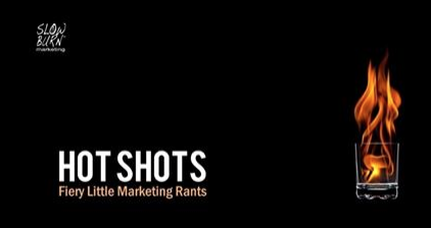 SON OF THE ATTACK OF THE BIG, BURNING, ROMANIAN BRANDING QUESTION... In our last episode, we left Petru, our Romanian in Atlanta, hanging by a thread. We'd answered part of his question about how to brand a small business. We'd also answered two questions he didn't ask--keys to solving the puzzle. Petru responded from the Peachtree State, saying, "IT IS AWESOME! I finally start to get it... Why does it have to be so confusing? I guess that the marketing GURUS must have confused me. :-)" Never once did Petru bemoan our bastardized use of his mother tongue. For that we thank him. More will follow. IN LIGHT OF ALL THAT, WE REALLY WILL PROVIDE THE REST OF THE ANSWER To recap for those among us who weren't here, weren't paying attention, or who've indulged in the recreational destruction of too many brain cells, our Romanian Man In Atlanta said he was confused about how to help a business brand itself. He noted that many experts say small businesses should do only direct-response marketing and no branding at all. And he wanted to know if there's a system that would help him figure out how to brand a small business? SO, WHAT DID WE TELL HIM? First, since aspires to have his own agency, we said it's important to be picky about who you work with. At Slow Burn Marketing, we take a client only if we'd look forward to having dinner with that person. Then, we answered the always burning, implicit question, "What is brand?" And as you know, since you pay attention in class... Brand is the ONE way your CORE CUSTOMER should FEEL about your business. ONE because focus is essential. CORE CUSTOMER because defining the person you're speaking to informs your brand voice. And FEEL because emotions are inseparable from decisions. (Thank you, Neuroscience, for proving this.) THEN WE WENT ABOUT BLOWING HOLES IN EXPERT DOGMA Some marketing experts decree that branding is a waste of time and money, and small businesses should not do branding, only direct marketing. That's just dumb. It's like saying, "Football players should not do weight training, only the inside run." The football metaphor brought joy to the football fans out there. There came a landslide of cards and letters saying things like, "Brilliant!" And "Solid!" One fan wished he could remember his Romanian. I told him that Google Translate is his friend. Or, as a Romanian might say if he were as linguistically stunted and prone to sounding like a Cold-War era cartoon character as your relentless scribe, Google Translate este prietenul tau. SO, WE'VE WASTED ABOUT HALF OUR AIR TIME IN RECAPPING Now what? Simple: we show you the meat. How do you help a small business brand, and is there a system? Funny you should ask. We believe there is no hard and fast system, not in the purest sense of systems. Too many soft and squishy variables. Some actual, genuine experts, like the very famous Sally Hogshead, might argue. But we're not going to even try to argue with her because she went to Duke University, and her name is much cooler than mine. So, if a system is a fixed series of steps that lead to a calculated outcome (like counting cards at blackjack), we do not use a system. The process of branding doesn't happen by the numbers. BUT YOU CAN BLAZE A TRAIL TO BRAND This is going to sound insanely simple. It's not. Want to brand someone's business? Start asking a boatload of questions. The Fabulous Honey Parker and I joke that what we do is like therapy. We ask questions and listen to the patient talk. We want to know everything there is to know about the business, ranging from, "Why do you do this?" to "What are some brands you love?" to "What's a really good day at work and how does it make you feel?" LIKE I SAID: SOUNDS INSANELY SIMPLE Again: It's not. You have to listen to each answer-and then know what else to ask. It's all about drilling way down and getting to the juice. It's about figuring out what really makes a small-business owner love the work they do and feel a need to do it. We want to hear the story of the business. If they have any employees, talking to those employees is useful. The employees get similar questions about why they love working there. (If they don't love working there, that's also worth knowing.) We talk to a few of the client's best customers. We ask what feels so good about working with the client's business. THEN, WE LEAVE We go away. We start processing all the soft information, feelings, emotions, beliefs, the story of the business. Here's an incredibly simplified example of how we work. Once upon a time, we lived in Los Angeles and we needed a roofer. We'd already called one roofer. It was a client of mine at the radio network where I was a Creative Director. Honey called (without revealing my connection to the business) because the campaign we'd done for them was so good, so full of reasons to like them, I wanted to hire them. Sadly, the visit from the guy who gave the estimate was unimpressive. The man inspired no confidence. And the price seemed really high. So I asked a friend for a referral. He gave a glowing recommendation for his own roofer. We called the guy. IT'S A NICE, SUNNY, CALIFORNIA AFTERNOON We're standing on the roof as the roofer looks around. We explain the competitor's estimate. He says, "That's really not necessary. It's a lot more than you need." He gives us a quote that's 80% lower. So we climb off the roof, sit down with him in the yard, have a beverage, and talk about roofing and marketing and advertising and shoes and ships and sealing wax. (If you're from Romania and have never read Alice In Wonderland, "shoes and ships and sealing wax" comes from a poem within the book called "The Walrus And The Carpenter." It's nonsense. Or, as they'd say in your country, prostii.) We also discuss integrity and performance and joy and doing good work. We ask a lot of questions and listen to him talk. Which is fun for him. After all, we want him on our side. And at one point, he suddenly says... "WHEN IT RAINS, I SLEEP REALLY WELL." Ding! The roofer suddenly rings the bell for a brand direction. The roofer who sleeps well when it rains. There would have been a whole lot more work to do on this brand. But at its core, it's a really smart way to begin branding this roofer. It's a tough category. Horror stories abound. Homeowners never know who to trust. The guy you want to hire is the guy who's happy and proud that his phone isn't going to be ringing on the days when LA turns into a mud river and everyone is swimming to and from their cars. THIS IS ONLY THE TIP OF THE ICEBERG This story greatly oversimplifies what we do in branding a business. But it is a nice little, illustrative gem about how it begins. You listen to people talk. You ask them questions. You let them wax poetic about their lives. And eventually, suddenly, you find yourself with a bright and shiny jewel that becomes your lodestar. (Petru, back home, lodestar would be Steaua polară.) WE HAVE NO SYSTEM AS MUCH AS WE HAVE AN ORDERED APPROACH You can have one, too. Because a few years ago, we wrote a book about our approach to brand. The book explains the thinking and orders the approach we take, and illustrates everything with real-life examples, many of which you know. Written by Blaine Parker (that's me) and The Fabulous Honey Parker, the book comes to the world via publishing giant Morgan James. It's called, Billion-Dollar Branding. Subtitle, Brand Your Small Business Like a Big Business and Make Great Things Happen. It looks like this:  Each chapter provides action items so the brand-curious reader can take steps to uncovering a brand. If you'd like to know more about it, click here to visit the book's page on Amazon. And bear in mind that there's work involved. This not some silver bullet. A brand does not miraculously pop into your head. It's real. It's understandable. It will make sense. As far as we know, this is the closest thing there is to a process for branding a business. And know, too, that selling you a single copy of that book is going to make us wealthy beyond our wildest dreams. So you can feel good about that, too. Click that link today, and tomorrow we are on our way to retirement in Bermuda. Go forth. Brand big. As always, Blaine Parker Your Lean, Mean Creative Director in Park City |
AuthorBlaine Parker is prone to ranting about any and all things related to brand. In many ways, he is a professional curmudgeon. While there is no known vaccine for this, the condition is also not contagious. Unless you choose it to be so. Archives
February 2022
Categories
All
|
|
© Copyright 2020 Slow Burn Marketing LLC |
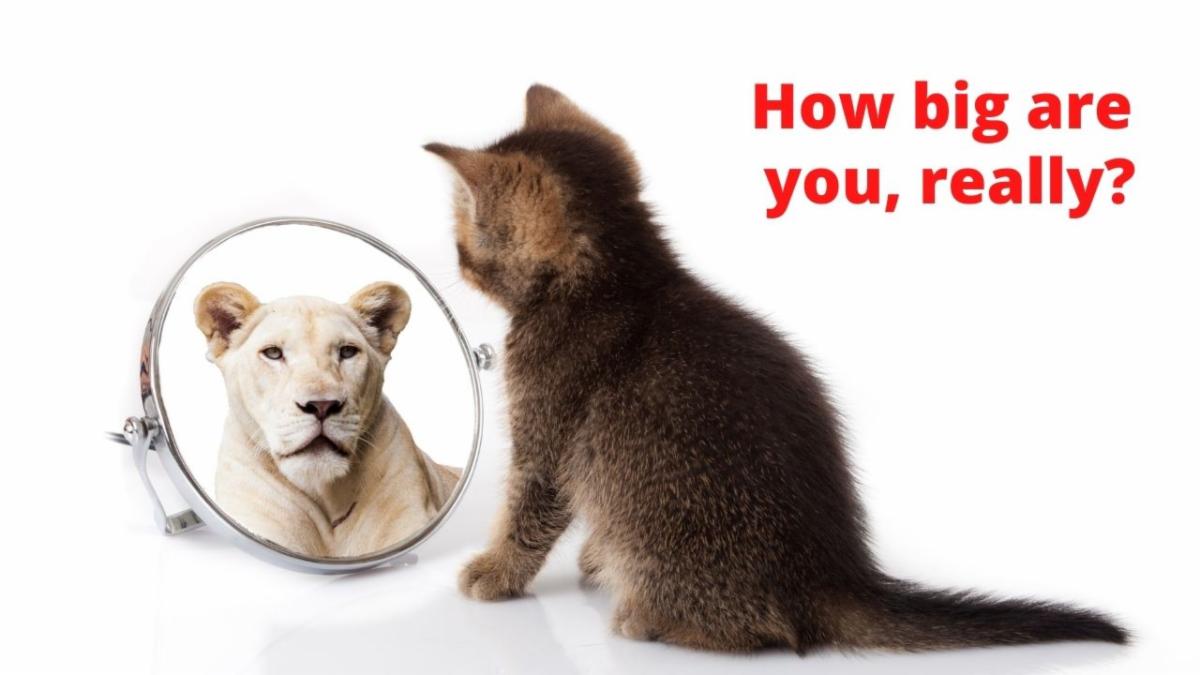
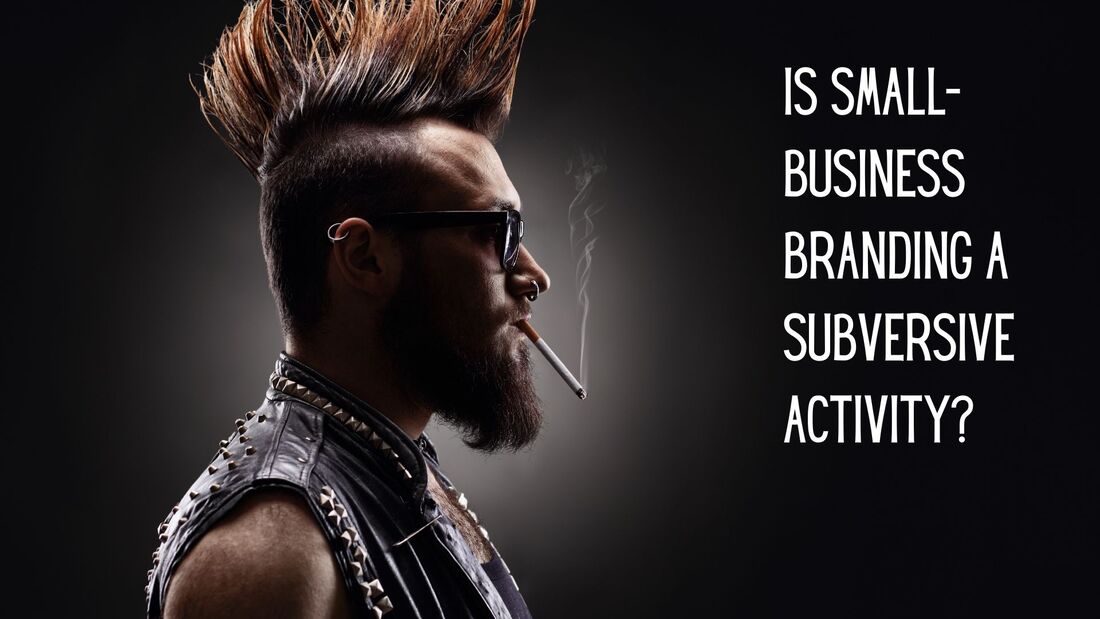
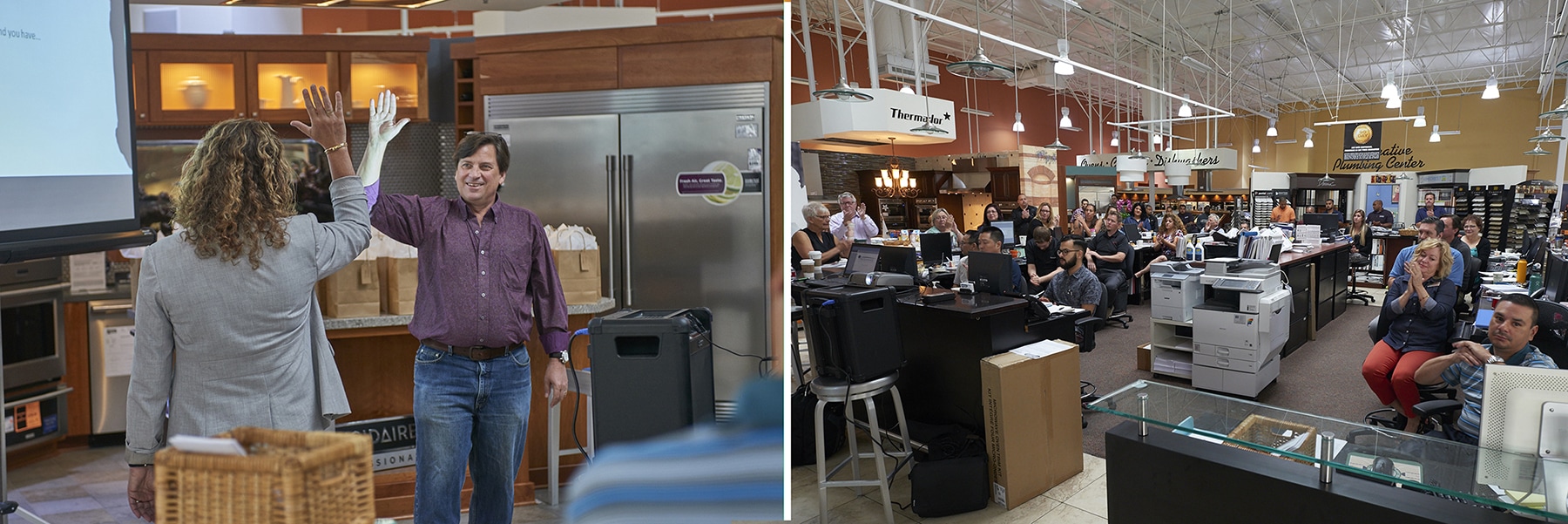
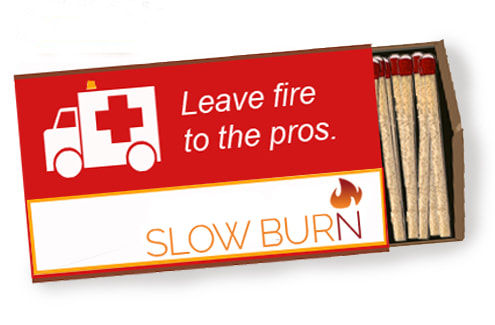
 RSS Feed
RSS Feed

